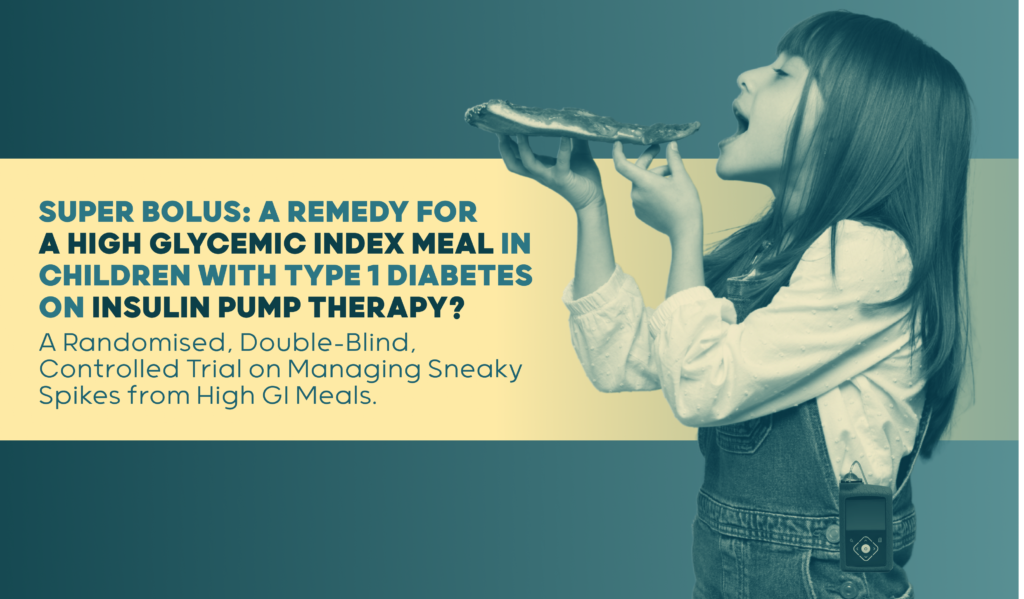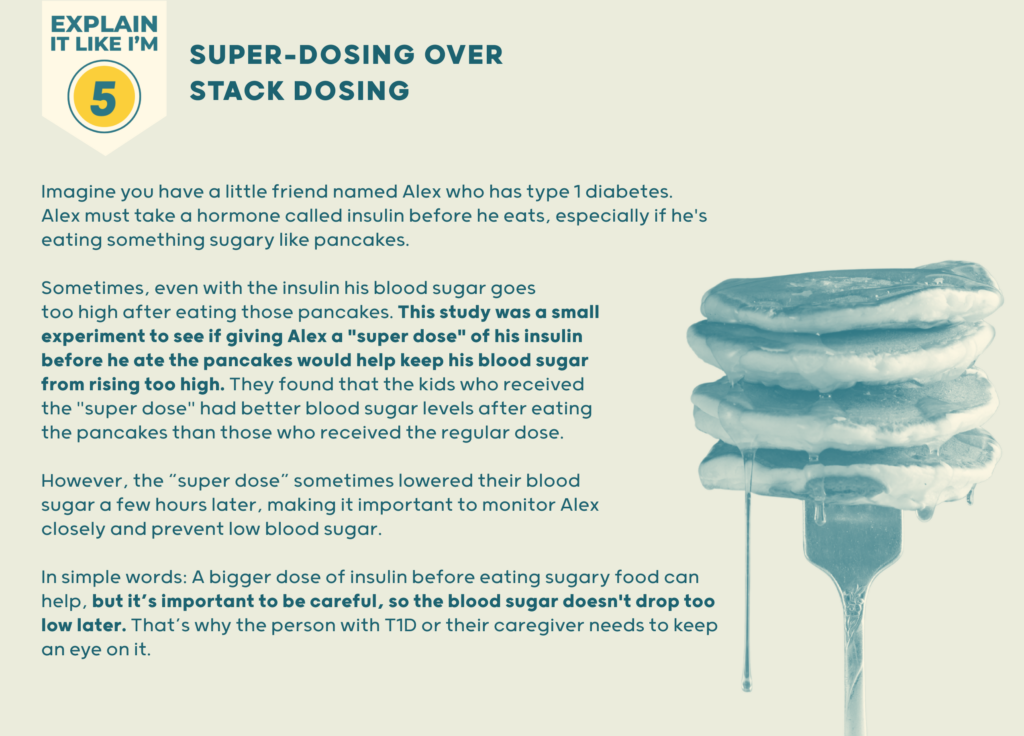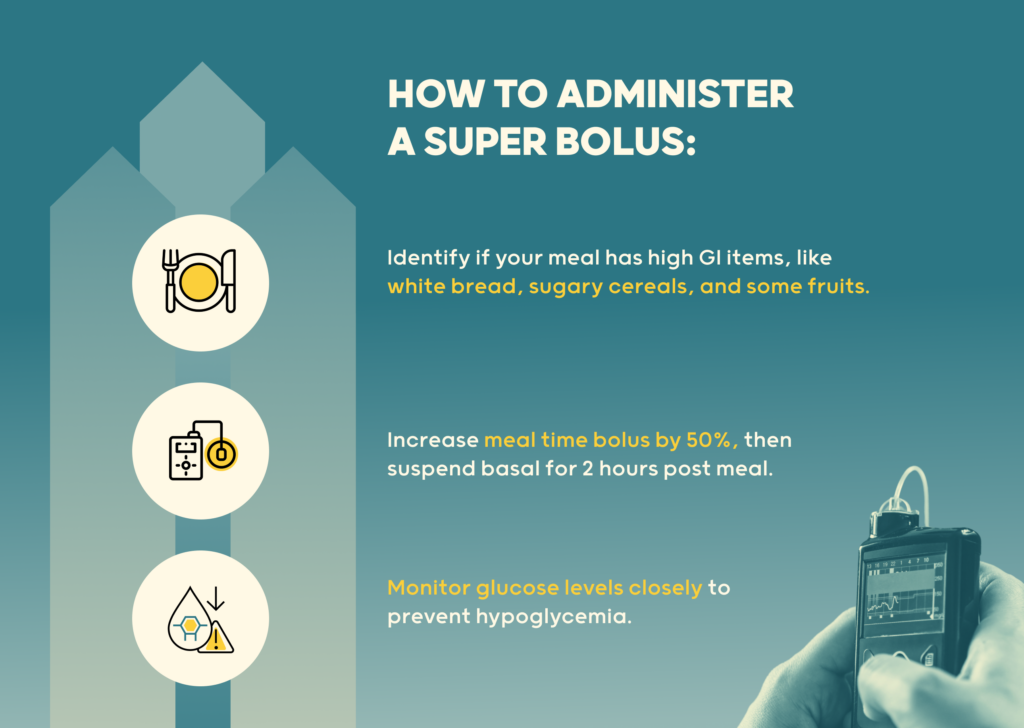Could a bigger insulin dose before meals a.k.a SUPER BOLUS help prevent spikes?
D-coding the Article- : Super Bolus—A Remedy for a High Glycemic Index Meal in Children with Type 1 Diabetes on Insulin Pump Therapy? —A Randomized, Double-Blind, Controlled Trial
Published Date:
16 January 2024
Published By:
Emilia Kowalczyk-Korcz, Magdalena Dymińska and Agnieszka Szypowska
Approved By:
To be
Decoded By:
Divina Chandiramani
10 mins to read
- The T1D Takeaway
- New research shows a 50% insulin boost with temporary basal shutoff helps kids on pumps tackle post-meal spikes. However, it ramps up hypoglycemia risk! Extending basal suspension time could unlock its full potential, offering faster post-meal control and safer diabetes management.
Word Wizard
- A super bolus strategy, which involves increasing the prandial insulin dose by 50% and suspending basal insulin for 2 hours, effectively lowers glucose levels and increases time in the target glucose range after high glycemic index meals in children with type 1 diabetes on insulin pump therapy.
- However, the super bolus strategy also led to a higher incidence of hypoglycemic episodes.
- The study suggests that to mitigate the risk of hypoglycemia, the basal insulin suspension period should be extended to 3 hours.

Summary Snap
Shots
- The Problem: High blood sugar spikes after meals (especially higher-carb ones) are a common challenge for people living with type 1 diabetes.
- Could a bigger insulin dose before meals (a “super bolus”) help prevent these spikes?
- Researchers compared a “super bolus” to a standard bolus among kids with type 1 diabetes eating a high-carb meal.
- The “super bolus” helped keep blood sugar lower after the meal but also increased the risk of low blood sugar later.
Prime Insight
The study investigated whether a larger insulin dose (super bolus) before a high-glycemic index meal could improve blood sugar control in children with Type 1 Diabetes compared to a standard bolus.
The super bolus was administered before a standardized high-carbohydrate breakfast.
Super Bolus Strategy: A 50% Insulin Boost addresses High Glucose, But Risks Lows.

The study found that the super bolus led to lower post-meal blood sugar levels, indicating better control of postprandial hyperglycemia. However, the study also revealed a higher incidence of hypoglycemia in the super bolus group, highlighting the importance of careful monitoring.

Extending Basal Suspension Time Could Provide Faster, Post-Meal Control, Especially for Kids with Type 1 Diabetes on Pumps.
The study suggests that the super bolus strategy may be a useful tool for managing post-meal blood sugar spikes in some individuals with Type 1 Diabetes.
But it highlights the importance of adjusting insulin doses carefully for each person to avoid low blood sugar.
- A Deeper Dive
- The Sources Voice
“It remains a clinical challenge to adjust the insulin dose and bolus pattern for h-GI meals. The goal of insulin therapy is to mimic as much as possible the physiological secretion of insulin. That is why in recent years the idea of the super bolus (SB) strategy is popular in context of h-GI products.”
- Curiosities Clarified
It’s a larger dose of insulin taken before a meal than you would normally take.
In this study they used a 50% increase, but the right amount for you depends on many factors. Don’t adjust your doses without talking to your doctor.
It might help prevent high blood sugar spikes after eating high-carb foods.
The main risk is low blood sugar (hypoglycemia), especially a few hours after the meal.
No. It’s important to talk to your doctor. It might not be right for everyone.
High-carb meals, like those with lots of bread, pasta, or sugary foods.

1 Comment
https://hrv-club.ru/forums/index.php?autocom=gallery&req=si&img=6889